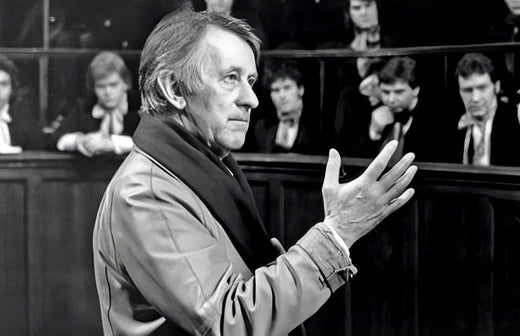Remembering Freddie Francis

It’s one of the most effective starts to any Hammer movie. A stormy evening. The sound of low thunder and the hooting of an unseen owl. A man furtively approaches a shack where a corpse lies supine across a wooden table. But when the inside door of the ramshackle home opens, we find a young girl entering, and we see what she sees -
A close-up of the dead man’s shoes as he’s pulled along the table. Flipped onto his front. The child screams. The man from earlier hauls the body through the window and makes off into the dusk. There’s no reverence or even respect in his actions. He could be shouldering a sack of coal for all the care he takes.
The girl runs into the woods, and already terrified, encounters a figure she instinctively knows to be evil. We instinctively know it’s Victor Frankenstein, so we applaud the kid’s intuition as she turns and flees. Meanwhile, the man with the cadaver walks along a cliff-edge. As he strides forward, the corpse’s dangling arms swish left and then right - a realistic yet curiously animated movement that presages what must surely follow…

‘Mr. Cushing is quite persuasive as the hounded, articulate hero. The color is excellent and subdued…’ - The New York Times on The Evil of Frankenstein.
We’re less than three minutes into The Evil of Frankenstein (1964) and before the titles have begun, before a word has been spoken, we know we’re being led into a dark and sinister, but compelling place. The visuals are grim and gorgeous. We’re made to feel the forest’s chill and the dead weight across the body-snatchers frame. But we never linger on any single shot. The person telling us this story, like Frankenstein, like the ghoulish thief, like the little girl, is impatient to move on.
Today we would say that the movie’s director, Freddie Francis, has a superpower. The way he captures and conveys movement and light is extraordinary.

Peter Cushing glistens with The Evil of Frankenstein…
He professed no great love for the type of film he helmed for Hammer. That’s not to say he didn’t enjoy his time with the studio, and he counted key figures within the company, like Anthony Hinds and Jimmy Sangster, amongst his close friends. He also held a huge amount of affection and regard for Peter Cushing. ‘He was a charming man and a consummate actor…’ he recalled. ‘Once shooting started, I knew Peter would be always reliable and always able to make any lines totally convincing and believable.’
Francis once commented, ‘Horror films have liked me more than I have liked horror films,’ but he was surely underplaying his affinity for the genre. One of his later collaborators, the great Martin Scorsese, pointed out his innate mastery of the field. ‘…the main thing was Freddie’s understanding of the concept of the gothic atmosphere,’ he observed.‘He understands the obligatory scene of a young maiden with a candle walking down a long hall towards a door. Don’t go in that door! you yell, and she goes in! Every time, she goes in! So I say to him, This has to look like The Hall, and he understands that.’

Janet (Jennie Linden) in Nightmare, venturing down ‘The Hall’…
Scorsese could almost be discussing the brilliant opening of another picture that Francis directed for Hammer. In Nightmare (1964) we open on a shot of an ominous-looking building perched on a hill. A jail perhaps. Night is falling and we glide towards the barred gates that serve as its entrance. If these few seconds vaguely bring to mind the very start of Citizen Kane (1941), we’re quickly into horror territory as we crossfade into the building and find we’ve been ushered into a corridor lined with locked cells. A petrified individual, Janet, pushes open a door and is confronted by its sole prisoner, an older woman who takes a sadistic delight in telling her, ‘They’ve got us both…’ She’s addressing Janet, but she may as well be talking directly to the audience, already gripped by this stark and eerie tale.

The woman in white… Isla Cameron brings the chills in Nightmare.
Francis’s visual style was effective but unfussy, something reflected in his view of movie-making technology (‘I think most bits of equipment are useful in their place…’) and his disdain for ‘effects pictures’. Clearly, he didn’t feel special effects were anything special, and he was equally down-to-earth in his overall take on getting the appropriate shot. ‘There are three types of photography: good photography, bad photography and the right photography. The right photography is what tells the story best.’
His other work with Hammer includes Paranoiac (1963) and Dracula Has Risen from the Grave (1968), both of which he directed. He later returned to cinematography and won an Academy Award for Glory (1989) to go with the Oscar he’d scooped over 25 years earlier for Sons and Lovers (1960).
Any full discussion of his awards, triumphs and body of work would require a book. Or two. Maybe three. But here we can simply salute Freddie Francis, and celebrate the work he did for Hammer and other studios in a career that spanned seven decades.

(l-r) Freddie Francis and Anthony Hinds meet during the shoot of Paranoiac (1963)
It’s tempting to think he was prouder than he admitted of his work on horror movies. ‘I love making films. I enjoyed my stay at Hammer,’ he told an interviewer in 1993. ‘I still get fan letters, one came this morning funnily enough… the letters come from all over, mostly the Continent. I’m their favourite figure.’
And even glimpsing the first few minutes of films like The Evil of Frankenstein or Nightmare, it’s easy to understand why.
Frederick ‘Freddie’ William Francis: December 22, 1917 - March 17, 2007


